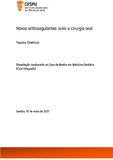| dc.contributor.advisor | MAGALHÃES, FRANCISCO JOSÉ VIEIRA DE | |
| dc.contributor.author | Chettouh, Yassine | |
| dc.date.accessioned | 2021-11-18T14:16:16Z | |
| dc.date.available | 2021-11-18T14:16:16Z | |
| dc.date.issued | 2021 | |
| dc.identifier.uri | http://hdl.handle.net/20.500.11816/3708 | |
| dc.description.abstract | Os anticoagulantes orais diretos estão no mercado há mais de 10 anos. Eles têm um mecanismo de ação diferente dos Antivitamínicos K (AVKs) e de outros anticoagulantes. Por conseguinte, é importante estudar estas moléculas e os seus efeitos nos doentes. Os médicos dentistas devem avaliar sistematicamente o risco de hemorragia antes de realizarem um procedimento cirúrgico. O objetivo deste trabalho é avaliar o risco hemorrágico de pacientes que estejam a tomar anticoagulantes orais diretos e que estejam programados para se submeterem a cirurgia oral. O segundo objetivo é propor elementos de resposta relativos à gestão destes pacientes em regime ambulatório, à aplicação ou não de um protocolo de hemostasia local e a necessidade ou não de interromper o tratamento antes de realizar a cirurgia.
Para a realização deste trabalho foram utilizados livros científicos e foi feita uma pesquisa bibliográfica na base de dados: PUBMED, desde 2011 até 2021, utilizando as seguintes palavras-chaves: (((anticoagulation) AND (tooth extraction)) AND (anticoagulants)) AND (bleeding). A fim de enriquecer o conteúdo teórico deste trabalho, foram acrescentados 16 artigos adicionais da literatura científica.
Dos artigos recolhidos, foram selecionados os que tratam dos anticoagulantes orais e dos riscos de hemorragias apos exodontia simples ou múltipla em língua inglesa e francesa. | pt_PT |
| dc.description.abstract | Direct oral anticoagulants have been on the market for more than 10 years. They have a different mechanism of action from Antivitamin K (VKAs) and other anticoagulants. It is therefore important to study these molecules and their effects on patients. Dentists should systematically assess the risk of bleeding before performing a surgical procedure. The aim of this work is to evaluate the bleeding risk of patients taking direct oral anticoagulants who are scheduled to undergo oral surgery. The second objective is to propose response elements regarding the management of these patients on an outpatient basis, the application or not of a local haemostasis protocol and the need or not to interrupt the treatment before performing surgery. For this study, scientific books were used, and a bibliographic search was made in the database: PUBMED, from 2011 to 2021, using the following keywords: (((anticoagulation) AND (tooth extraction)) AND (anticoagulants)) AND (bleeding)). In order to enrich the theoretical content of this work, 16 additional articles from the scientific literature were added.
Of the articles collected, those dealing with oral anticoagulants and the risks of bleeding after single or multiple extractions in English and French were selected. | pt_PT |
| dc.language.iso | por | pt_PT |
| dc.rights | info:eu-repo/semantics/openAccess | pt_PT |
| dc.subject | Anticoagulation | pt_PT |
| dc.subject | Tooth extraction | pt_PT |
| dc.subject | Anticoagulants | pt_PT |
| dc.subject | Bleeding | pt_PT |
| dc.title | Novos anticoagulantes orais e cirurgia oral | pt_PT |
| dc.type | info:eu-repo/semantics/masterThesis | pt_PT |
| dc.identifier.tid | 202781135 | pt_PT |
| thesis.degree.name | Mestrado em Medicina Dentária | pt_PT |

